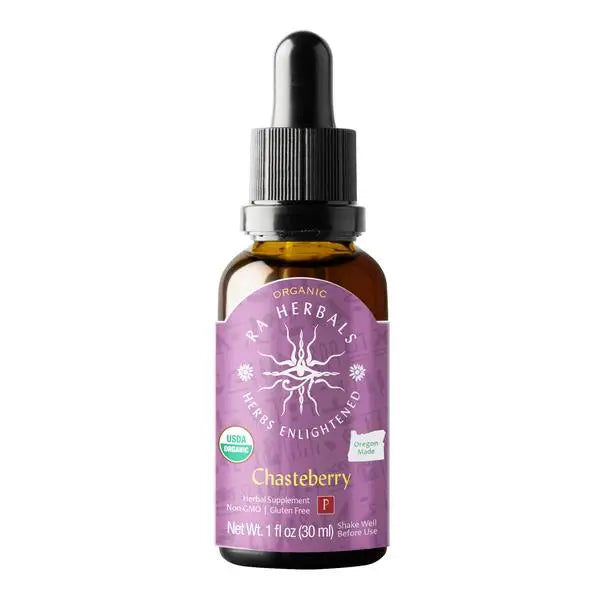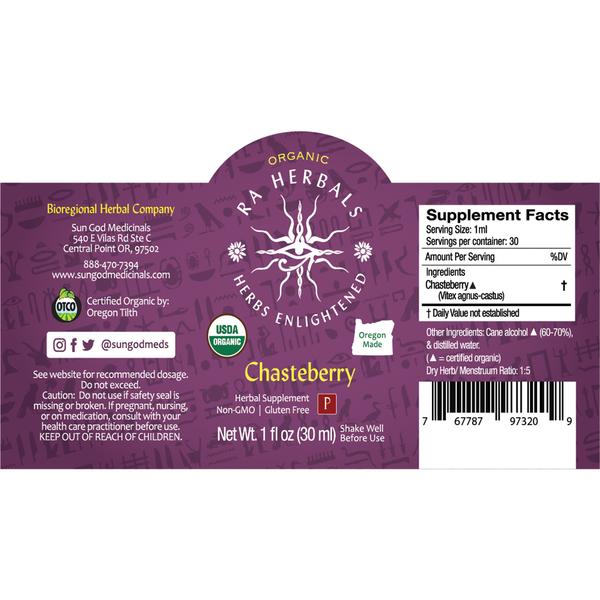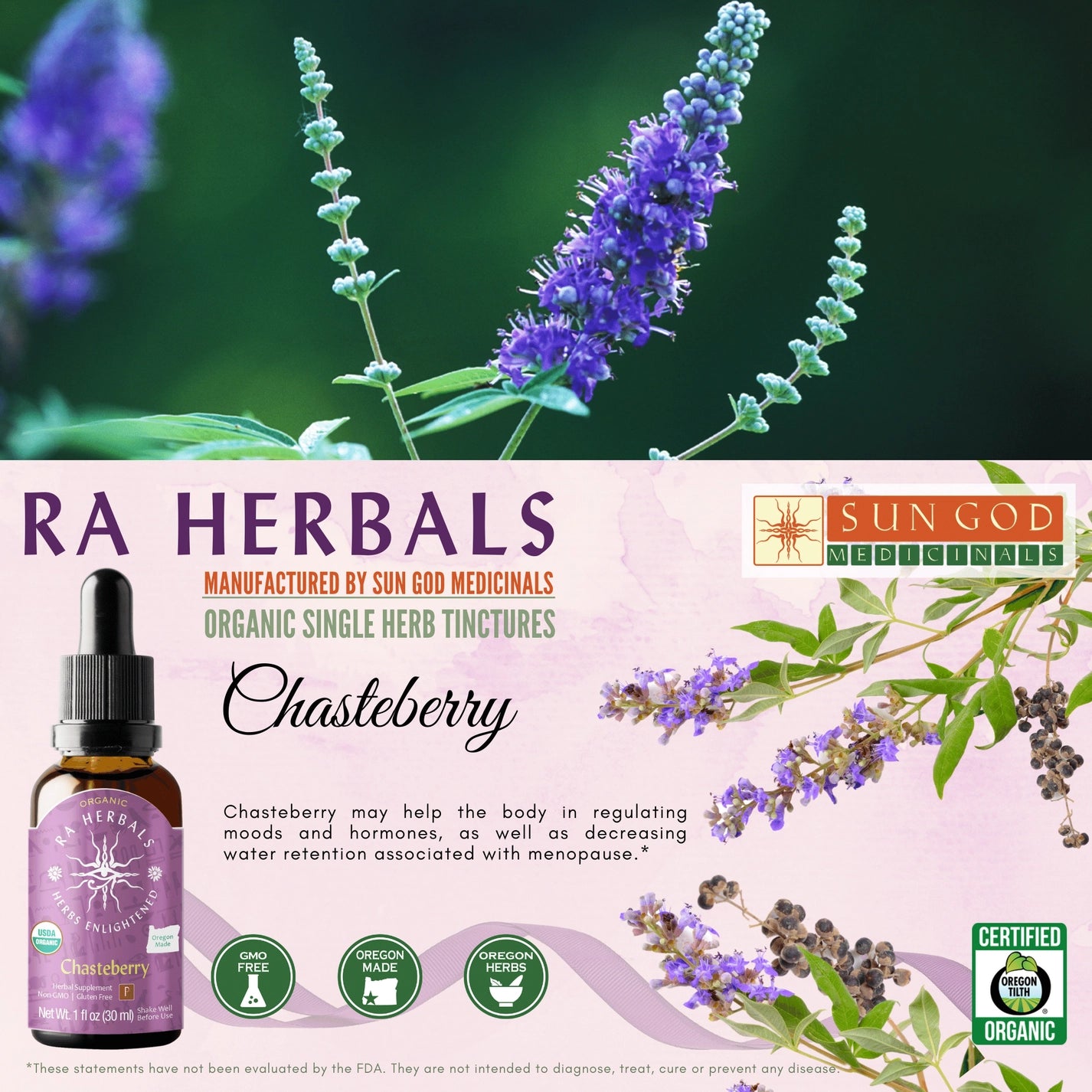Sun God Medicinals
Chasteberry (Vitex) Tincture 1 oz Ra Herbals Certified Organic
Chasteberry (Vitex) Tincture 1 oz Ra Herbals Certified Organic
Couldn't load pickup availability
A certified organic single herb tincture of Chasteberry (Vitex agnus-castus).
Chasteberry may help the body in regulating moods and hormones, as well as decreasing water retention associated with menopause.*
Ingredients: certified organic alcohol, distilled water & certified organic chasteberry.
Region: Grown in Southern Oregon.
-
Chasteberry liquid extract
- Herbal supplement
- Certified organic
- Gluten free
- Non GMO
- Rapidly absorbed
The Ra Herbals line focuses exclusively on single-herb extracts from Southern Oregon. These tinctures are extracted using a slow, cold-process method practiced by herbalists for thousands of years. We only use certified organic or wildcrafted medicinal herbs in our products. All our products are manufactured in the USA by hard working people who truly care about what they do. This shines through in the quality of our products.
Recommended Usage: Shake well before use. Place 1 serving under the tongue for 1 minute then swallow. Work with your healthcare provider to determine daily maximum and duration. -
Suggested use 2 to 4 times per day. Work with your healthcare provider to determine daily maximum and duration.
Caution:*These statements have not been evaluated by the FDA. They are not intended to treat, cure or prevent any diseaseKeep out of reach of children.
If pregnant, nursing, or on medication, consult with your health care practitioner before use.
All herbs have the potential for producing side effects and causing interactions with supplements and medications you are taking. Ask your doctor before use.
Herb Spotlight - Chasteberry
Chasteberry (Vitex agnus castus)
Family: Lamiaceae
Part Used: Fruit
Flavor/Aroma: Sweet, Pungent, Bitter
Energetics: Warming, Drying
Overview:
Chasteberry, or commonly known as Vitex, has been revered for its ability to regulate hormonal conditions and has been used as a remedy for a variety of female reproductive issues. It has historical usage dating back to the ancient Greeks, and has been supportive with a variety of inflammatory conditions.

Botany:
Chasteberry grows as a small perennial shrub with finger-like leaves and small violet flowers. It thrives best in sunny creek beds, at the edge of river banks, and in the lower foothill regions of the Meditteranian and of Central Asia, and is drought tolerant. After pollination, the fruit develops into a dark-brown fruit with a pepper like aroma and flavor.
Cultivation and Harvesting:
Chasteberry is best harvested after the fruit has dried to a brown-black color, resembling peppercorns, which usually occurs in the early to late fall.
Southern Oregon Cultivation:
Chasteberry can be found in the wild in Southern Oregon and Northern California. It thrives best in full sun and well drained soil of this area, due to its sensitivity to moisture and tendency to get oversaturated. It can be planted as an ornamental shrub bearing showy blooms each summer, and is known for attracting local pollinators.
History and Folklore:
Ancient Greek Uses: Chasteberry has been mentioned by Hippocrates, Dioscoride, and Theophrast as a remedy for general injuries, inflammation, swelling of the spleen; the leaves were infused into wine to treat hemorrhoids as well. Chasteberry was used for wild animal bites and edema.
“If blood flows from the womb, let the woman drink dark red wine in which the leaves of the chaste tree have been steeped. A draft of Chaste leaves in wine also serves to expel a chorion help fast in the womb.” - Corpus Hippocratum, Hippocrates
Other Traditional Uses: Chasteberry was known as “monk’s pepper” and used as a spice in many dishes in Southern Europe; it has been used to support lactation issues, infertility, uterine fibroids, and PMS symptoms. Chasteberry branches were also placed under the pillow of those who wish to preserve their chastity, or a tea was brewed and drank to suppress sexual desires.
Modern Applications:
Chasteberry is indicated to support the regulation of the menstrual cycle, menopausal symptoms, and fertility issues. It has shown to be supportive as a phytoestrogenic therapy that can help regulate estrogen levels by mitigating premenstrual symptoms through decreasing the hormone levels that contribute to symptoms like irritability and abdominal pain.³
Uses and Preparations:
Dried Herb Tea Preparation:
Vitex berries can be crushed and added to meals for a peppery aroma.
Using a reusable tea bag or tea ball, immerse the loose dried herbs into boiling water and allow to steep for 5-10 minutes, preferably covered, in order to release the maximum amount of herbal goodness. Some herbal tea can carry a strong flavor. We recommend organic honey as a sweetener which preserves the beneficial herbal compounds.
Tincture:
2-4 mL up to 3 times per day.
Some herbal tinctures can have a strong flavor on their own. Adding your tincture to a glass of 6-8oz of water is one easy way to help, should you wish to dilute the flavor.
Recommended Usage:
It is important to remember that some bodies may react differently than others when using herbal products. Our recommended usage amounts are designed to be an average dosage only. If you have specific concerns about the usage amount or interaction with other medication, please consult with your doctor or health care practitioner prior to using our products.
Share






